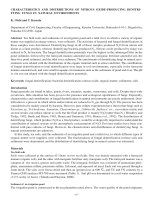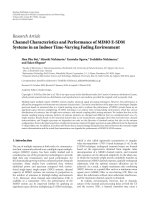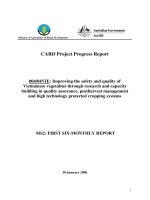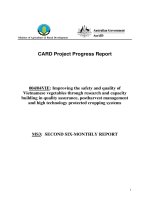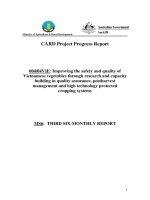CEO Characteristics and Timeliness of Financial Reporting of Vietnamese Listed Companies
Bạn đang xem bản rút gọn của tài liệu. Xem và tải ngay bản đầy đủ của tài liệu tại đây (177.3 KB, 8 trang )
<span class='text_page_counter'>(1)</span><div class='page_container' data-page=1>
100
CEO Characteristics and Timeliness of Financial Reporting
of Vietnamese Listed Companies
Nguyen Vinh Khuong
1,*<sub>, Nguyen Thi Xuan Vy</sub>
2<i>1<sub>University of Economics and Law - Vietnam National University, Ho Chi Minh City, </sub></i>
<i>Quarter 3, Linh Xuan Ward, Thu Duc Dist., Ho Chi Minh City, Vietnam </i>
<i>2<sub>Saigon University, 273 An Duong Vuong, Dist. 5, Ho Chi Minh City, Vietnam </sub></i>
Received 13 September 2017
Revised 15 December 2017; Accepted 25 December 2017
<b>Abstract: Timeliness of financial reporting is a qualitative characteristics that enhance the </b>
usefulness of information and significant to users of financial statements. This study examines the
impact that board diversity (GENDERCHAIR) and CEO age (CEOAGE) have on audit report
timeliness. The sample of this study comprises of 100 companies listed on the Vietnamese Stock
Exchange in the period 2012-2014. Ordinary Least Square (OLS) regression analysis is performed
to test the audit report timeliness determinants. Using quantitative research methods, the study
found that there is a significant positive relationship between board diversity on timeliness of
financial reporting while proxy variables of the CEO age have a significant negative relationship
with timeliness of financial reporting. This paper extends prior research by addressing the potential
effects of female executives on timeliness of financial reporting. The findings reported in this
paper provide novel insights for the empirical financial accounting literature.
<i>Keywords: Chief executive officer, timeliness of financial reporting, listed firms, Vietnam. </i>
<b>1. Introduction *</b>
The timeliness of audit reporting is the time in
which financial statements will be examined by
the external auditors who report about the truth
and fair of financial reports [1]. Some studies
indicate that the audit report is timely when
auditors complete statutory audit in the short time.
Based on that, companies will publish a set of
annual audited financial statements within
statutory time [2]. For instance, higher trust in
audited financial reports, lower asymmetric
information and favorable content in audit report
are stated for companies which have timely audit
_______
*<sub> Corresponding author. Tel.: 84-935997116</sub>
Email:
<b> />
report [3, 4]. In fact, there are so much
advantages of timeliness of audit reports that
the effects of timeliness’ audit reporting have
got much more attention [5- 8]. Several
determinants in relation to timely audit report
have been investigated; however, factors of
corporate governance have just been taken into
account [9, 10]. In prior researches, one of CEO
characteristics, which is called CEO duality,
was included in the model of timeliness’ audit
report. Moreover, this model also stated that
significant negative effect of CEO duality on
timely audit reporting.
</div>
<span class='text_page_counter'>(2)</span><div class='page_container' data-page=2>
managers. Some studies suggest that a CEO
may pay much attention to not only strategic,
operational and financial decisions [11] but also
earnings management and corporate disclosures
[1, 12]. Moreover, it is believed that the overall
audit process is really affected by the CEO
although a CEO does not control over the audit
report date. There are some investigations of the
impact of CEO gender and CEO age on the
timeliness of audit report. It is indicated that
manager’s characteristics have significantly
impact on organizational outcomes and
financial reporting [13]. Therefore, in the case
of that shareholders, investors, boards of
directors and auditors including the manager’s
characteristics in manager assessments, it is
expected that the audit report lag may be also
affected by these characteristics.
This study contributes to the literature
concerning audit report timeliness by providing
the first evidence of the effect of CEO gender
and CEO age on timeliness of financial
reporting in Vietnam. That is because the
timeliness of audit report is a product of the
interaction of the firm’s managers and external
auditors. Also, this causes that the
characteristics of the management are
significantly influenced by the interaction.
In Vietnam, there are a few studies about
determinants of timely audit report or timely
financial statements. In recent years, the author
have just found that Dang Dinh Tan (2013)
studied the impacts on the timeliness of the
financial reporting in Vietnamese listed
companies. However, there is no study about
the effects of CEO characteristics and timely
audit report or financial reports. Therefore, the
results of this study have a crucial implication
for shareholders and boards of directors in
selecting a new CEO. In addition, this study
underlines the importance of controlling CEO
characteristics in terms of country regulations.
In most developed and developing markets,
regulatory bodies focus and organize the
characteristics of governance mechanisms
instead of the characteristics of the CEO.
<b>2. Literature review and hypotheses </b>
The prior literature of relationship between
accounting and corporate governance supported
that CEO’s have really concerned their
interests. That leads to motivating them to
control and develop the company’s resources
for meeting their own interests instead of
maximizing the shareholders’ wealth [14, 15].
Some research also indicate that CEO can
restate financial statements to conceal their
behavior of frauds by applying and
implementing more aggressive accounting
policies that negative influence governance
mechanisms.
According to Knechel and Sharma (2012),
Knechel (2012), Wan-Hussin and Bamahros
(2013), Mohamad-Nor (2010), Al-Ajmi (2008)
pointed out that the behavior of the CEO is
affected by CEO characteristics, including age,
experience, education, tenure, career
background, gender, and duality [6-10]. In fact,
CEO’s features can be used to predict the
impact of a CEO on financial statements
because these attributes play an important role
in creation of the CEO’s behavior. Thus, the
company’s outcomes have been effected by
CEO’s attributes [1]. However, some point of
views gave significant evidence of that CEO’s
characteristics positively affected the CEO’s
behavior. For example, they can improve the
quality of financial reporting. Zhang, Y., &
Wiersema (2009) concluded that the market
participants will perceive the signal of financial
statements’ quality by the CEO’s attributes
[16]. In the extent of this study, the authors
have focus on the gender and age of a CEO and
the brief review of pertinent literature and
developing hypotheses for investigating the
relation between these attributes and the
timeliness’ financial reporting.
<i>The CEO’s gender </i>
</div>
<span class='text_page_counter'>(3)</span><div class='page_container' data-page=3>
actions which enhance the corporate
performance and value.
Based on agency theory, more diverse
board makes the control of managers better
because the independence of managers can be
enhanced by board diversity. The main point of
this case is that women are director who will
provide more important information to the
board and making strategic decision is also
increased. On the other hand, diversity of board
can enhance the information process; thus,
valuable and timely information is disclosed to
the information’s users, especially, the board
and managers [18]. Therefore, it is expected
that the participation of women in the board
will increase the quality of financial reporting.
<i>H1: Board diversity is positively associated </i>
<i>with timeliness of the financial reporting. </i>
<i>CEO age </i>
Our study also contributes to the timeliness
of financial reporting by providing empirical
evidence of an relation of the timeliness of
financial reporting and CEO’s age. It is
suggested that elder CEO in the organization is
more conservative in preparing and disclosing
financial statements. Some prior research
indicated that individuals who have been in the
position of CEO for many years will become
more ethical and prudent. And also, they are
less likely to engage in earnings management
and thus, the quality of financial reporting will
be improved [20, 21, 22]. As result of this,
auditors seem to spend less time conducting the
audit process and issuing audit report timely.
Therefore, the timeliness of disclosing financial
statements is increased. Thus, it is hypothesized
that:
<i>H2: CEO age is negatively associated with </i>
<i>timeliness of the financial reporting. </i>
<i>Control variables </i>
Profitability is a financial ratio that is used
to assess that the company will be able to gain
earnings and whether the organization operated
effectively. In fact, for organizations, favorable
information of corporate performance will be
disclosed more promptly. The performance of
company is seen as a signal and a factor that
influence on management skills and the firm’s
securities. Therefore, for companies with good
performance, auditors take much more time to
engage the audit than companies with losses.
However, based on agency theory, profitable
companies will disclose financial information
earlier to prove good performance of
management enhance shareholders' confidence
in managers [23, 24]. Moreover, companies
with bad performance will extend the time of
financial information disclosure in order to
avoid financial rumors in the market [10, 25,
26, 27].
Several studies indicated that audit lag is
negatively affected by company size which is
measured by natural logarithm of total assets.
Bigger companies always have strong internal
system. Thus, according to Owusu-Ansah
(2000) [28], auditors spend less time on
conducting substantive tests of financial
statements. On the other hand, more accounting
staff and sophisticated accounting information
systems will be settled in larger companies that
makes financial disclosure more timely. In
addition, financial analysts usually base on the
timely financial statements of companies to
confirm and revise expectations of their present
and future economic prospects. Finally,
managers in big organizations may have
incentives to decrease the time of disclosing
financial statements because they are controlled
by shareholders and statutory agencies. Thus, it
is expected that timeliness of financial
disclosure is negatively associated with
company size.
</div>
<span class='text_page_counter'>(4)</span><div class='page_container' data-page=4>
This variable indicates the corporate’s
ability of growth in future in term of investment
efficiency in the company [29]. Growth
opportunities is measure by growth index in
sum of assets, growth in sale or growth in book
value to market value ratio. In this study, it
measures as the ratio of book value (the sum of
equity in the end of year) to market value
(published and in hand stock multiple by stock
market value in the end of year). Findings of
previous research revealed that growth
opportunities have a direct effect on the quality
of financial reporting [30]. It means that firms
with higher growth opportunities have high
effectiveness on financial reporting quality.
Thus, it helps auditors spend less time engaging
in audit procedures. Audit report will be issued
timely and financial statements will be also
disclosure timely as well.
<b>3. Data and variables </b>
<i>3.1. Sample description </i>
In this study, the data set includes 100
companies listed before 2009 on Vietnamese
stock markets (HNX and HOSE) in the period
from 2012 to 2014. All of the companies has
disclosed a full set of reports, such as financial
statement and annual report. The data has
excluded companies in bank sector, financial
sector and securities sector. Following the
above sample selection process, a total of 300
observations are collected. The sample was
derived from 380 listed companies. Moreover,
data were get from 2012 to 2014 because the
financial information would be significantly
changed when firms adopted The Circular
200/2014.
<i>3.2. Variables </i>
Our dependent variable is the timeliness of
audit report. It is used as the main measure of
timely audit reporting which is defined as the
number of days from the fiscal year end date to
the date of audit report authenticity date and
signature.
In this study, eight independent variables
are used in this research board diversity
(GENDERCHAIR), CEO age (CEOAGE),
profitability (PROFIT), company size (SIZE),
subsidiaries (SUBs), complexity of operation
(OPERA), and growth opportunities (PB). As
far as independent variables are concerned, we
have selected several proxies that appear in the
empirical literature.
- GENDERCHAIR which is defined as
one of the following alternative chairman
executive dummies: GENDERCHAIR equals
one if the chairman of the firm is female .
- CEO Age is the CEO’s age at the
beginning of year t; CEOAGE = logarit
(CEO Age).
- PROFIT is net profit which gets from
annual income statement .
- SIZE is the size for a company in a
given industry at a given time which results in
natural logarithm of total assets .
- SUBs is a number of subsidiaries in the
company which are got from annual reporting
or financial statement .
- OPERA is defined as the complexity of
the company’s operation. OPERA equals one if
the firm includes more than a field of operation.
- PB is defined as the ability of firm’s
growth in future view. This variable is
measured by the price to book ratio.
<b>4. Research methodologies </b>
</div>
<span class='text_page_counter'>(5)</span><div class='page_container' data-page=5>
Research model:
TIME1i,t = β0 + β1 GENDERCHAIRi,t + β2 CEOAGEi,t + β3 PROFITi,t + β4 SIZEi,t + β5 SUBsi,t + β6
OPERAi,t + β7 PBi,t + ε
Table 1. Proxies, expected relationship
<b>No. </b> <b>Independent/Control variables </b> <b>Hypothesis </b>
<b>Name </b> <b>Sign </b>
1 The gender of the CHAIR GENDERCHAIR (+)
2 The age of the CEO CEOAGE (-)
3 The profitability PROFIT (-)
4 The company size SIZE (+)
5 Subsidiaries of company SUBs (+)
6 The complexity of operation OPERA (+)
7 The growth opportunities PB (-)
<i>Source: Authors summary. </i>
<b>5. Results </b>
The mean of the variable explains the
average days taken for issuing the audit report
with respect to the number of days from the
fiscal year end date to the date of the audit
report authenticity date and signature in the
sample of this study. From Table 1 it also can
be stated that companies in this study use a
maximum of 107 days to issue their audit report
from the date on the financial statement.
To test the correlation between the
variables, the Pearson correlation coefficient
was used. With this test how variables move
from each other has been measured. The
correlations between the variables in Table 3
gives a first indication about the sign and the
influence of the variables in determining
timeliness. The correlation of 0.0674 for
GENDERCHAIR and TIME1 indicates that
there is a positive relation between the
variables. The same applies for the SIZE,
SUBs and OPERA with a correlation of
0.1843, 0.1255 and 0.1520. CEOAGE,
PROFIT and PB are negatively related, with a
correlation of -0.1951, -0.0251 and -0.0700.
Table 2. Descriptive statistics of sample variables
<b>Variable </b> <b>Obs </b> <b>Mean </b> <b>Std.Dev </b> <b>Min </b> <b>Max </b>
TIME1 300 75.14 15.43658 10 107
GENDERCHAIR 300 0.1266667 0.3331549 -17 80
CEOAGE 300 3.894463 0.1590249 3.3673 4.26268
PROFIT 300 1.11*e11 <sub>5.67*e</sub>11 <sub>-2.23*e</sub>12 <sub>7.15*e</sub>12
SIZE 300 27.17643 1.551747 23.1799 32.1362
SUBs 300 2.17333 5.337752 0 55
OPERA 300 0.86 0.3475668 0 1
PB 300 0.9088667 0.7322189 0.21 5.31
</div>
<span class='text_page_counter'>(6)</span><div class='page_container' data-page=6>
Table 3. Pearson correlation coefficient matrix
<b>TIME1 </b> <b>GENDER </b>
<b>CHAIR </b> <b>CEOAGE </b> <b>PROFIT </b> <b>SIZE </b> <b>SUBs </b> <b>OPERA PB </b>
TIME1 1.0000
GENDERCHAIR 0.0674 1.0000
CEOAGE -0.1951 0.1428 1.0000
PROFIT -0.0251 -0.0243 -0.0157 1.0000
SIZE 0.1843 -0.0579 -0.0400 0.3948 1.0000
SUBs 0.1255 -0.0481 -0.0805 0.7358 0.4804 1.0000
OPERA 0.1520 -0.1063 0.0707 0.0526 0.1743 0.1159 1.0000
PB -0.0700 0.0258 0.0608 0.5799 0.3445 0.5394 0.0911 1.0000
<i>Source: Pearson correlation with STATA. </i>
Table 4 presents the results of the Pooled
Regression Models that have been estimated to
examine the impact of CEO characteristics on
the audit report timeliness of selected
companies controlling the effect of firm specific
variables.
The regression model tests the relationship
between the timeliness of the audit report,
which measured by the number of days from
the date at financial statements to the date of
issuing the audit report, and CEO
characteristics and firm’s characteristics as
well. As revealed in Table 4, the result of the
regression model indicates a significantly
positive relationship between the timeliness of
the audit report (TIME1) and the gender of
chair (GENDERCHAIR). It is a fact that
women’s joint presence in the board will not
mean that audit report will be issued quickly.
The result is consistent with the findings of
previous studies such as Stephenson (2004),
Robinson and Dechant (1997), Owusu-Ansah
(2000), Owusu-Ansah and Leventis (2006) [31,
18, 28, 32].
Moreover, CEO age (CEOAGE) negatively
affect the timeliness of issuing of the audit
report at 1 percent level of significance. In fact,
younger CEOs are likely to engage in earnings
management for improving their position which
makes auditors spend much more time
conducting the audit. Thus, issuing the audit
report is not timely. Moreover, older CEOs
often have reputation for self-image and
conservatism, so they are less likely to use
earnings management than younger CEOs. For
control variables, company size (SIZE) at a
5 percent level of significance and subsidiaries
(SUBs), company’s profitability (PROFIT) and
complexity of company’s operation (OPERA)
at a 1 percent level of significance. In addition,
the growth opportunities of the company also
impact on timely audit reporting at a 5 percent
level of significance. Growth opportunities are
likely to improve the quality of financial
statements and also, auditors will engage in the
audit more quickly. Therefore, they will be able
to make a timely issue of the audit report. This
finding is consistent with previous studies [10,
20-27].
Table 4. The regression results of model
<b>Regression model </b>
Variables Coef. P>| t |
GENDERCHAIR **6.07509 0.023
CEOAGE ***-18.61383 0.001
PROFIT ***-4.9*e-12 <sub>0.004 </sub>
SIZE **1.704514 0.015
</div>
<span class='text_page_counter'>(7)</span><div class='page_container' data-page=7>
OPERA ***6.487603 0.004
PB **-3.256978 0.030
Observations 300
R-squared 14.51%
P_Value > X2 <sub>= 0.0000 *** </sub>
<i>Source: Regression with STATA.</i>
<b>6. Conclusion </b>
The empirical evidence shown in this study
offers further insights into the determinants of
audit report timeliness. Two crucial CEO
characteristics are included, namely board
diversity and CEO age, and are among the
factors significantly affecting audit report
timeliness. This is because it is believed that a
CEO has a significant influence on the quality
of financial reporting and that these
characteristics have an influence on the
behavior of CEOs.
<b>7. Limitations </b>
Similar to the prior research [10, 26, 27],
this study is not isolated from limitations that
suggest caution in the interpretation of the
results. First, it is recognized that the setting
prevents the investigation from being enriched
due to the lack of public disclosure, and
insufficient cooperation between the companies
and academic society. For example, the
additional characteristics of the CEOs, such as
shareholding and compensation were not
considered. Second, empirical results are based
on a small sample size and particularly on the
data of nonfinancial companies; thereby
limiting the generalization of the results to
similar institutional settings and jurisdictions,
and lowering the statistical power of the various
tests, although bootstrap resampling method has
been used to overcome this problem. Thus, such
limitations warrant future research to re-explore
this issue and to test the overall generalization
of the findings to other jurisdictions.
<b>References </b>
[1] Bamber, E. M., Bamber, L. S., & Schoderbek,
M. P., “Audit structure and other determinants of
audit report lag: An empirical analysis”,
Auditing, 12 (1993) 1, 1-23.
[2] Ettredge, M. L., Sun, L. and Li, C., “The impact
of SOX section 404 internal control quality
assessment on audit delay in the SOX era”,
Auditing: A Journal of Practice & Theory, 25
(2006) 2, 1-23.
[3] Carmichael, D., Ghosh, A. and Lee, H., “Causes
and consequences of abnormally long audit
reporting lags”, in Bishop, C. C., ed. American
Accounting Association Annual Meeting,
Colorado, Wednesday August 10, 2011, Denver,
Colorado: American Accounting Association
(2011), 1-41.
[4] Mande, V. and Son, M., “Do audit delays affect
client retention?”, Managerial Auditing Journal,
26 (2011) 1, 32-50.
[5] Munsif, V., Raghunandan, K. and Rama, D. V.,
“Internal control reporting and audit report lags:
Further evidence”, Auditing: A Journal of
Practice & Theory, 31 (2012) 3, 203-218.
[6] Knechel, W. R. and Sharma, D. S.,
“Auditor-provided non audit services and audit
effectiveness and efficiency: Evidence from
pre-and post-SOX audit Report Lags”, Auditing:
A Journal of Practice & Theory, 31 (2012) 4,
85-114.
[7] Knechel, W. R., Sharma, D. S. and Sharma, V.
D., “Non-audit services and knowledge
spillovers: Evidence from New Zealand”,
Journal of Business Finance & Accounting, 39
(2012) 1-2, 60-81.
[8] Wan-Hussin, W. N. and Bamahros, H. M., “Do
investment in and the sourcing arrangement of
the internal audit function affect audit delay”,
Journal of Contemporary Accounting &
Economics, 9 (2013) 1, 19-32.
</div>
<span class='text_page_counter'>(8)</span><div class='page_container' data-page=8>
Management Journal of Accounting & Finance,
6 (2010) 2, 57-84.
[10] Al-Ajmi, J., “Audit and reporting delays:
Evidence from an emerging market”, Advances
in Accounting, 24 (2008) 2, 217-226.
[11] Bertrand, M. and Schoar, A., “Managing with
Style: The Effect of Managers on Firm Policies”,
The Quarterly Journal of Economics, 118,
(2003) 4, 1169-1208.
[12] Bergstresser, D. and Philippon, T., “CEO
incentives and earnings management”, Journal
of Financial Economics, 80 (2006) 3, 511-529.
[13] Francis, J., Huang, A. H., Rajgopal, S. and Zang,
A. Y., “CEO reputation and earnings quality”,
Contemporary Accounting Research, 25 (2008)
1, 109-147.
[14] Cohen, J., Krishnamoorthy, G., & Wright, A.
M., “Corporate governance and the audit
process”, Contemporary accounting research, 19
(2002) 4, 573-594.
[15] Klein, A., “Audit committee, board of director
characteristics, and earnings management”,
Journal of Accounting and Economics, 33
(2002) 3, 375-400.
[16] Zhang, Y., & Wiersema, M. F., “Stock market
reaction to CEO certification: The signaling role
of CEO background”, Strategic Management
Journal, (2009), 693-710.
[17] Walt, N., & Ingley, C., “Board dynamics and the
influence of professional background, gender
and ethnic diversity of directors”, Corporate
Governance: An International Review, 11 (2003)
3, 218-234.
[18] Robinson, G., & Dechant, K., “Building a
business case for diversity”, The Academy of
Management Executive, 11 (1997) 3, 21-31.
[19] Catalyst, “The bottom line: Connecting
corporate performance and gender diversity”,
2004, />Bottom_Line_Connecting_Corporate_Performan
ce_and_Gender_Diversity.pdf.
[20] Mudrack, P., “Age-related differences in a
Machiavellian adult sample”, Psychology
Report, 64 (1989) 2, 1947-1950.
[21] Peterson, D., A. Rhoads, and B. C. Vaught,
“Ethical beliefs of business professionals: A study
of gender, age and external factors”, Journal of
Business Ethics, 31 (2001) 3, 225-233.
[22] Sundaram, R. K., & Yermack, D. L., “Pay me
later: Inside debt and its role in managerial
compensation”, The Journal of Finance, 62
(2007) 4, 1551-1588.
[23] Inchausti, B. G., “The influence of company
characteristics and accounting regulation on
information disclosed by Spanish firms”,
European accounting review, 6 (1997) 1, 45-68.
[24] Al-Akra, M., Eddie, I. A., & Ali, M. J., “The
influence of the introduction of accounting
disclosure regulation on mandatory disclosure
compliance: Evidence from Jordan”, The British
Accounting Review, 42 (2010) 3, 170-186.
[25] Nelson, S. N., & Shukeri, S. N., “Corporate
governance and audit report timeliness:
Evidence from Malaysia”, in Accounting in Asia
(2011), 109-127, Emerald Group Publishing
Limited.
[26] Khasharmeh, H. A., & Aljifri, K., “The
timeliness of annual reports in Bahrain and the
United Arab Emirates: An empirical
comparative study”, The International Journal of
Business and Finance Research, 4 (2010) 1,
51-71.
[27] Che-Ahmad, A., & Abidin, S., “Audit delay of
listed companies: A case of Malaysia”,
International business research, 1 (2009) 4, 32.
[28] Owusu-Ansah, S., “Timeliness of corporate
financial reporting in emerging capital markets:
Empirical evidence from the Zimbabwe Stock
Exchange”, Accounting and Business Research,
30 (2000) 3, 241-254.
[29] Khademi, V., “The relation between investment
opportunities and asset growth among the
companies accepted in Tehran Stock Exchange”,
Accountant 207 (2009), 74-77.
[30] Rafiee, S. Z., Rafiee, S. Z., & Heidarpoor, F.,
“The effective factors of financial information
quality in listed companies on Tehran Stock
Exchange”, International Journal of Accounting
and Financial Reporting, 4 (2014) 2, 201.
[31] Stephenson, C., “Leveraging diversity to
maximum advantage: The business case for
appointing more women to boards”, Ivey
Business Journal September/October 2004, 1-5.
[32] Owusu-Ansah, S., & Leventis, S., “Timeliness
of corporate annual financial reporting in
Greece”, European Accounting Review, 15
(2006) 2, 273-287.
</div>
<!--links-->
